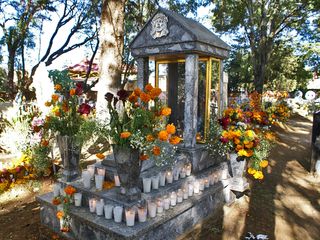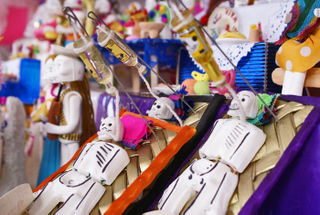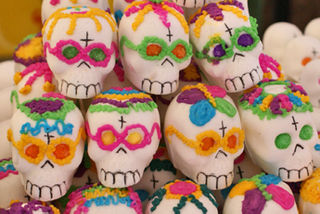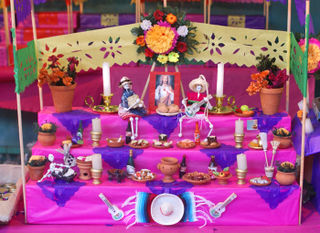
Highly decorated calaca de cartón (cardboard skull) for Noche de Muertos (Night of the Dead) decor.
For the last several days here in Michoacán, people have been cleaning up their family members' graves at local cemeteries. Everything is ready for the wonderful Noche de Muertos (Night of the Dead) festivities during the first two days of November.

Pantéon Municipal (Municipal Cemetery), Tzintzuntzan, Michoacán. Mexico Cooks! photo from Noche de Muertos 2009.
Mexico Cooks! is touring Morelia and Pátzcuaro again during this special time of year. We've attended one or another special Noche de Muertos event every day for an entire week! Traditional ofrendas (altars dedicated to the dead), spectacular crafts exhibits, concerts, and annual concursos (contests) have filled our days and nights. Known in most parts of Mexico as Día de Muertos (the Day of the Dead), here in Michoacán we call the night of November 1 Noche de Muertos (Night of the Dead). By either name, the festival as it's celebrated in Mexico is unique in the world.

These four-inch-long skeletal figures, laid out on their petates (woven rush mats), are hooked up to intravenous bottles of either beer or tequila! Mexico Cooks! has more information about all of the special figures for Noche de Muertos.

Tiny sugar footwear no more than two inches long, in styles from baby booties to high-heeled pumps, is ready to be given as gifts or for placement on an ofrenda. You'll find many more Night of the Dead photos from 2009 on Mexico Cooks!.
Mexico celebrates death as it celebrates life, with extreme enjoyment in the simplest things. Life and death are both honored states. The home ofrenda (altar) usually memorializes a cherished relative, while an altar in a business is normally built to the memory of a political figure (either reviled or beloved), or a figure from the entertainment world. Traditional decorations include the cempasúchil (marigold) and cordón del obispo, pata de león or terciopelo, all regional names for cockscomb flowers, which are used in profusion in churches, cemeteries, and homes.

Sugar skulls are often inscribed in icing with a living friend's name and given to that person as a small token of admiration.
Relatives take favorite foods and beverages to the grave of a loved one gone before. It's said that the dead partake of the spirit of the food, while the living enjoy the physical treats at the cemetery.

Pan de muertos (bread of the dead) is decorated with bone-shaped bread and sugar. The bread itself is flavored with orange and anise.

This miniature ofrenda (altar) is filled with tiny representations of treats that the deceased loved in life.
Several years ago, an article in the New York Times quoted Mexico Cooks! about the Noche de los Muertos: "There's a mutual nostalgia. The living remember the dead, and the dead remember the taste of home." That nostalgia imbues the cities and villages of Michoacán at this time of year just as surely as do woodsmoke and the scent of toasting tortillas.
Looking for a tailored-to-your-interests specialized tour in Mexico? Click here: Tours.
Leave a Reply